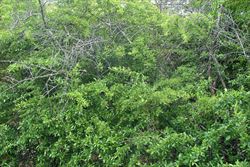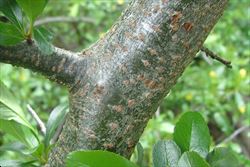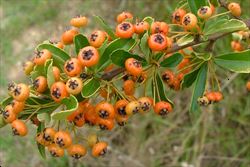Click on images to enlarge

infestation (Photo: Sheldon Navie)

habit with new growth in spring (Photo: Sheldon Navie)

habit in fruit in summer (Photo: Sheldon Navie)

older branches (Photo: Sheldon Navie)

younger branch with short side branches ending in spines and relatively broad leaves (Photo: Sheldon Navie)

light green young leaves with toothed margins (Photo: Sheldon Navie)

close-up of leaf undersides (Photo: Sheldon Navie)

clusters of flower buds (Photo: Sheldon Navie)

immature fruit (Photo: Sheldon Navie)

close-up of hairless immature fruit (Photo: Sheldon Navie)
Scientific Name
Pyracantha crenatoserrata (Hance) Rehder
Synonyms
Photinia crenatoserrata HancePyracantha fortuneana (Maxim.) H. Li (misapplied)
Family
Malaceae (New South Wales)Rosaceae (Queensland, the ACT, Victoria, Tasmania, South Australia and Western Australia)
Common Names
broad leaf firethorn, broad-leaf firethorn, Chinese firethorn, firethorn, pyracantha, Yunnan firethorn
Origin
Native to China.
Cultivation
Cultivated as a garden ornamental, particularly in the temperate regions of Australia.
Naturalised Distribution
Widespread, but scattered, in south-eastern Australia (i.e. in many parts of eastern New South Wales, in the ACT and in north-eastern and central Victoria).
Also naturalised overseas in southern USA (i.e. California, Alabama and Florida) and Hawaii.
Habitat
A potential weed of open woodlands, forests, urban bushland, grasslands and waterways in temperate and sub-tropical regions.
Habit
A large, sprawling and spiny shrub usually growing 1-3 m tall but occasionally reaching up to 4 m in height.
Distinguishing Features
- a large sprawling and spiny shrub growing 1-4 m tall.
- its leaves (2.5-5 cm long and 1-2 cm wide) are narrowly oval to egg-shaped in outline with almost entire margins and rounded tips.
- these leaves are hairless with dark green and glossy upper surfaces and paler undersides.
- its flowers are borne in dense clusters and have five white petals (8-9 mm long) and numerous stamens.
- its small glossy berry-like fruit (6-8 mm across) usually turn crimson or dark red in colour when ripe.
Stems and Leaves
The young stems are somewhat woolly at first but turn glossy and develop sharp spines as they mature. Short lateral branches are formed off the main branches and these bear the majority of the leaves.
Leaves are alternately arranged along the main branches (25-50 x 10-20 mm in size) and often appear to be clustered on the short side branches. They are borne on stalks (i.e. petioles) 5-10 mm long and are narrowly oval (i.e. elliptic), egg-shaped in outline (i.e. obovate), oblong or somewhat lance-shaped (i.e. lanceolate). Their margins are either entire or slightly toothed (i.e. crenate) and they have rounded tips. These leaves are hairless (i.e. glabrous) and have dark green upper surfaces that are glossy in appearance.
Flowers and Fruit
Flowers are borne in dense clusters usually at the tips of the short side branches. They have five white petals (8-9 mm long), numerous stamens and are borne on hairy (i.e. pubescent) flower stalks (i.e. pedicels). Flowering occurs during spring and summer.
The fruit are berry-like in appearance (actually 'pomes') and turn crimson, scarlet, dark red or sometimes orange in colour when ripe. They are rounded but slightly flattened at both ends (6-8 mm across) and glossy in appearance.
Reproduction and Dispersal
This species reproduces entirely by seed. Seeds are most commonly dispersed by birds and other animals (e.g. foxes) that eat the fruit, but may also be spread by water and in dumped garden waste.
Environmental Impact
Broad-leaf firethorn (Pyracantha crenatoserrata) is regarded as an environmental weed in New South Wales, the ACT and Victoria.
Legislation
This species is declared under legislation in the following states and territories:
- ACT: C4 - prohibited pest plant (a pest plant whose propagation and supply is prohibited).
- Western Australia: Prohibited - on the prohibited species list and not permitted entry into the state.
Similar Species
Scarlet firethorn (Pyracantha coccinea) is very similar to orange firethorn (Pyracantha angustifolia), broad-leaf firethorn (Pyracantha crenatoserrata), Nepalese firethorn (Pyracantha crenulata) and Roger's firethorn (Pyracantha rogersiana). These species can be distinguished by the following differences:
- scarlet firethorn (Pyracantha coccinea) has relatively broad leaves (10-20 mm wide) with finely toothed (i.e. crenulate) margins. These leaves have pointed tips and undersides that are hairless (i.e. glabrous) or slightly hairy (i.e. puberulent). Its mature fruit are bright red or scarlet in colour and are usually hairless (i.e. glabrous).
- orange firethorn (Pyracantha angustifolia) has relatively narrow leaves (5-13 mm wide) with entire margins. These leaves have rounded tips and undersides that are densely covered with white hairs (i.e. tomentose). Its mature fruit are yellow to deep orange in colour and are usually covered in white hairs (i.e. pubescent).
- broad-leaf firethorn (Pyracantha crenatoserrata) has relatively broad leaves (10-20 mm wide) with almost entire or slightly toothed (i.e. crenulate) margins. These leaves have rounded tips and undersides that are hairless (i.e. glabrous). Its mature fruit are bright red in colour and are usually hairless (i.e. glabrous).
- Nepalese firethorn (Pyracantha crenulata) has relatively narrow leaves (6-10 mm wide) with sharply toothed (i.e. serrate) margins. These leaves have pointed tips and undersides that are hairless (i.e. glabrous). Its fruit are bright red or dark red in colour and are usually hairless (i.e. glabrous).
- Roger's firethorn (Pyracantha rogersiana) has relatively narrow leaves (5-10 mm wide) with bluntly toothed (i.e. crenate) margins. These leaves have rounded tips and undersides that are hairless (i.e. glabrous). Its fruit are yellow to reddish-orange in colour and are usually hairless (i.e. glabrous).
Orange firethorn (Pyracantha angustifolia) is also relatively similar to the cotoneasters (Cotoneaster spp.) and hawthorns (Crataegus spp.). However, the cotoneasters (Cotoneaster spp.) can be distinguished by the lack of spines on their stems, and the hawthorns (Crataegus spp.) can be distinguished by their deeply toothed or lobed leaves.

